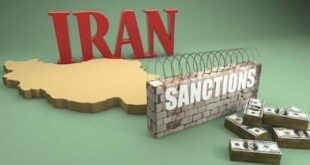The Art of Sanctions – Author’s Introduction: Examining the strategy of sanctions—how they work in changing a sanctioned state’s actions—is critical now because, like it or not, sanctions have become a favorite instrument of U.S. foreign policy and have the potential of becoming a favorite of other major global powers…
Mauood’s Introduction: The author of the present book (The Art of Sanctions) is Richard Nephew. Richard Nephew was in charge of the sanctions team against Iran during Obama’s second term. He supported the nuclear negotiators in the matter of sanctions in Vienna. Richard Nephew has previously served for ten years as an Iran member of the National Security Council at the White House and as Deputy Secretary of State for Coordination of Sanctions at the State Department. The book is also translated into Persian by the Iranian Parliamentary Research Center (IPRC).
Note: The content of this book is not approved by us and is published solely to familiarize policymakers with the views, approaches, and methods of the designers of sanctions against Iran.
Author’s Introduction
authors of works on sanctions are required by practice, if not yet by law, to begin their projects with a reaffirmation that sanctions have been in use since the ancient Greeks. This emphasis of the historical basis of the instrument is intended to demonstrate that, though sanctions may take different forms today, there is continuity in foreign policy thinking no matter how the cultural or political contexts have changed.
But referring to this historical continuity obscures a fundamental difference in how sanctions were viewed in the past, how they are viewed and used today, and how they achieve results.
Prior to the past hundred years, sanctions were typically an extension of a hostile relationship, often if not always involving military action either before or after sanctions were deployed.
Though there are examples of sanctions regimes prior to the 1900s in which the tool was considered itself a sufficient threat or punishment to prevent conflict and achieve a diplomatic victory, it was not until the 1900s that sanctions began to be wielded with any frequency as an independent instrument of foreign policy.
This evolution may have had as much to do with the increasingly total nature of warfare—starting with World War I —as it did with a desire on the part of statesmen to avoid the bloodshed that would otherwise come with their international intrigue.
With war increasingly violent and destructive, robbing states of their economic power and people of their lives, strategists began to seek new ways of imposing their will on opponents. Economic power seemed a ripe avenue for many, particularly in a Cold War environment that—for all its peripheral violence—did not include the direct confrontation many expected and feared.
Examining the strategy of sanctions—how they work in changing a sanctioned state’s actions—is critical now because, like it or not, sanctions have become a favorite instrument of U.S. foreign policy and have the potential of becoming a favorite of other major global powers. Russia—when faced with a need to respond to the Turkish downing of one of its fighter jets over an airspace violation in 2016—chose the application of economic sanctions over more militaristic options, despite the apparent bellicosity of its present administration.
Russia is not alone. China has similarly taken aim at South Korea’s decision to accept the basing of a Terminal High Altitude Area Defense (THAAD) system from the United States in response to North Korean ballistic missile testing by targeting tourism, trade, and South Korean luxury hotels.[1]
Since 1960, dozens of countries have used economic sanctions to enforce their will in a variety of settings.[2]
Yet, even as sanctions took on a new role in the foreign policy tool kit, they often remain trapped in a conceptual vacuum in public discourse, without form or function to govern assessment of their appropriate role in a state’s strategy. The contours of success and failure of the tool in individual circumstances have been well studied.
There are countless works by serious scholars of international affairs that assess the effectiveness of sanctions or compare the utility of this tool against others. But there are far fewer works on how sanctions are designed by practitioners and combined with other tools to deliver a comprehensive strategy.
This book is largely about the U.S. sanctions effort against Iran from 1996 to 2015, which I (and others) judge to have been successful as part of a broader strategy of preventing Iran’s acquisition of nuclear weapons. Parts of it are written anecdotally, owing to my direct, personal involvement in this project. But these are anecdotes grounded in the facts, figures, and theories of sanctions design that were part of the overall endeavor. Moreover, this book is no memoir.
Rather than fixate on individual incidents or salacious details (of which there are few, but perhaps more than might be imagined), this book seeks to present the U.S. sanctions campaign in its proper context of national strategy as a means of illustrating how sanctions can be done properly (even if through examples of tactical failures and setbacks).
To do so, this book will examine the two main attributes of a sanctions strategy: a sanctioning state applying pain against a target and the target state’s resolve to persist in whatever it did to prompt sanctions. Through this analysis, this book aims to help development of sanctions strategies that identify the intersection of escalating pain and diminishing resolve, at which a diplomatic negotiation can be most effective. Iran will be the primary example, but others will also be noted in their proper context.
At its heart, this book focuses on the relationship that exists between a state’s application of pain against another state via sanctions to achieve a defined objective and the readiness of sanctions targets to resist, tolerate, or overcome this pain and pursue its own agenda. It seeks to demonstrate that this relationship is critical for making any determination as to the effectiveness of sanctions as an implement of strategy. And, as further chapters will reveal, it also focuses on the importance of sanctions design not just in how measures can be targeted but also in evaluating whether they should be used at all.
From these central attributes comes a simple framework for sanctioning states to follow in order for sanctions to perform their expected function. A state must
- identify objectives for the imposition of pain and define minimum necessary remedial steps that the target state must take for pain to be removed;
- understand as much as possible the nature of the target, including its vulnerabilities, interests, commitment to whatever it did to prompt sanctions, and readiness to absorb pain;
- develop a strategy to carefully, methodically, and efficiently increase pain on those areas that are vulnerabilities while avoiding those that are not;
- monitor the execution of the strategy and continuously recalibrate its initial assumptions of target state resolve, the efficacy of the pain applied in shattering that resolve, and how best to improve the strategy;
- present the target state with a clear statement of the conditions necessary for the removal of pain and an offer to pursue any negotiations necessary to conclude an arrangement that removes the pain while satisfying the sanctioning state’s requirements; and
- accept the possibility that, notwithstanding a carefully crafted strategy, the sanctioning state may fail because of inherent inefficiencies in the strategy, a misunderstanding of the target, or an exogenous boost in the target’s resolve and capacity to resist. Either way, a state must be prepared either to acknowledge its failure and change its course or accept the risk that continuing with its present course could create worse outcomes in the long run.
To the last point, I take the perspective that sanctions do not fail or succeed. Rather, sanctions are either helpful to achieving the desired end result of a sanctioning state or not. A state (and a state’s strategy) can be said to have succeeded or failed, including in the state’s employ of sanctions as a tool to achieve its national strategy.
But it is ridiculous to say that “sanctions” either succeed or fail independent of whether the strategy through which they were being employed succeeded or failed, just as it would be ridiculous to argue that military force does not “work” on the basis of one failed campaign or war. Plainly put, tools can only perform well when they are employed with a proper strategy; one can’t blame the saw if it fails to perform the work of a screwdriver.
The case of Iran is instructive here. Simply by reading the newspapers in 2012, one could easily get the impression that sanctions were failing for a long time or that their failure was inevitable given the pace of Iranian technical achievement. And, after the initial nuclear deal was reached in 2013 (and consolidated in a comprehensive one in 2015), one could argue in contrast that sanctions were inevitably going to create the kind of condition in which a deal with Iran could be struck, success having been guaranteed the moment sanctions begun to bite. Both lines of argument are wrong.
They take too linear an approach to sanctions application and too restrictive a mindset to their value. Sanctions worked in achieving a deal with Iran in 2013 because of the combined action of many moving parts of strategy (and perhaps a good measure of propitious timing and luck). They were a necessary but not sufficient condition for success. And in the execution of our sanctions-equipped strategy, the many deficiencies of the tool were exposed, from which we can learn much.
Before further developing this framework, I must define some of our terms and discuss their intellectual context, limits, and uses.
Footnotes:
1. Xie Tao, “How Did China Lose South Korea?,” The Diplomat, March 9, 2017, http://thediplomat.com/2017/03/how-did-china-lose-south-korea/.
2. Gary Hufbauer, Jeffrey Schott, and Ann Elliott, Economic Sanctions Reconsidered, 3rd ed. (Washington, DC: Peterson Institute for International Economics, 2007), appendix 1A.
 Mouood Mouood English Edition
Mouood Mouood English Edition




